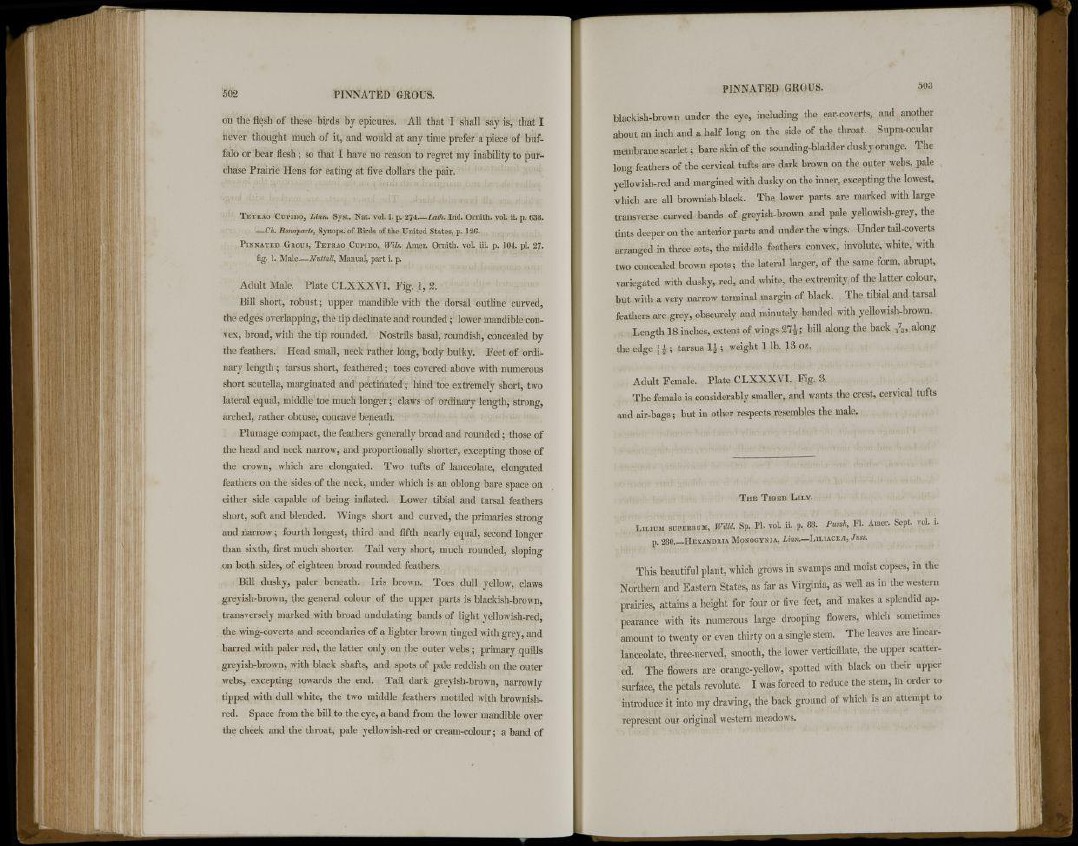
on the flesh of these birds by epicures. All that I shall say is, that I
never thought much of it, and would at any time prefer a piece of buffalo
or bear flesh ; so that I have no reason to regret my inability to purchase
Prairie Hens for eating at five dollars the pair.
TETEAO CUPIDO, Linn. Syst. Nat. vol. i. p. 274—Lath. Ind. Omith. vol. ii. p. 638.
—Ch. Bonaparte, Synops. of Birds of the United States, p. 12G.
PINNATED GROUS, TETRAO CUPIDO, Wils. Amer. Ornith. vol. iii. p. 104. pi. 27.
fig. 1. Male Nuttall, Manual, part i. p.
Adult Male. Plate CLXXXVI. Fig. 1, 2.
Bill short, robust; upper mandible with the dorsal outline curved,
the edges overlapping, the tip declinate and rounded; lower mandible convex,
broad, with the tip rounded. Nostrils basal, roundish, concealed by
the feathers. Head small, neck rather long, body bulky. Feet of ordinary
length ; tarsus short, feathered; toes covered above with numerous
short scutella, marginated and pectinated; hind toe extremely short, two
lateral equal, middle toe much longer; claws of ordinary length, strong,
arched, rather obtuse, concave beneath.
Plumage compact, the feathers generally broad and rounded; those of
the head and neck narrow, and proportionally shorter, excepting those of
the crown, which are elongated. Two tufts of lanceolate, elongated
feathers on the sides of the neck, under which is an oblong bare space on
either side capable of being inflated. Lower tibial and tarsal feathers
short, soft and blended. Wings short and curved, the primaries strong
and narrow; fourth longest, third and fifth nearly equal, second longer
than sixth, first much shorter. Tail very short, much rounded, sloping
on both sides, of eighteen broad rounded feathers.
Bill dusky, paler beneath. Iris brown. Toes dull yellow, claws
greyish-brown, the general colour of the upper parts is blackish-brown,
transversely marked with broad undulating bands of light yellowish-red,
the wing-coverts and secondaries of a lighter brown tinged with grey, and
barred with paler red, the latter only on the outer webs ; primary quills
greyish-brown, with black shafts, and spots of pale reddish on the outer
webs, excepting towards the end. Tail dark greyish-brown, narrowly
tipped with dull white, the two middle feathers mottled with brownishred.
Space from the bill to the eye, a band from the lower mandible over
the cheek and the throat, pale yellowish-red or cream-colour; a band of
blackish-brown under the eye, including the ear-coverts, and another
about an inch and a half long on the side of the throat. Supra-ocular
membrane scarlet; bare skin of the sounding-bladder dusky orange. The
long feathers of the cervical tufts are dark brown on the outer webs, pale
yellowish-red and margined with dusky on the inner, excepting the lowest,
which are all brownish-black. The lower parts are marked with large
transverse curved bands of greyish-brown and pale yellowish-grey, the
tints deeper on the anterior parts and under the wings. Under tail-coverts
arranged in three sets, the middle feathers convex, involute, white, with
two concealed brown spots; the lateral larger, of the same form, abrupt,
variegated with dusky, red, and white, the extremity of the latter colour,
but with a very narrow terminal margin of black. The tibial and tarsal
feathers are grey, obscurely and minutely banded with yellowish-brown.
Length 18 inches, extent of wings 27£; bill along the back ft, along
the edge \^ ; tarsus 1 \ ; weight 1 lb. 13 oz.
Adult Female. Plate CLXXXVI. Fig. 3.
The female is considerably smaller, and wants the crest, cervical tufts
and air-bags; but in other respects resembles the male.
THE TIGER LILY.
LILIUM SUPERHUM, Willd. Sp. PI. vol. ii. p. 88. Pursh, Fl. Amer. Sept. vol. i.
p. 280 HEXANDRIA MONOGYNIA, Linn.—LILIACEJE, JUSS.
This beautiful plant, which grows in swamps and moist copses, in the
Northern and Eastern States, as far as Virginia, as well as in the western
prairies, attains a height for four or five feet, and makes a splendid appearance
with its numerous large drooping flowers, which sometimes
amount to twenty or even thirty on a single stem. The leaves are linearlanceolate,
three-nerved, smooth, the lower verticillate, the upper scattered.
The flowers are orange-yellow, spotted with black on their upper
surface, the petals revolute. I was forced to reduce the stem, in order to
introduce it into my drawing, the back ground of which is an attempt to
represent our original western meadows.